Here is an idea for (immutable / "mutable"-by-reconstruction / zipperable) ADT representation (involving immutable vectors):
module Data.BTree.Internal where
import Data.Vector
type Values v = Vector v
type Keys k = Vector k
data Leaf k v
= Leaf
{ _leafKeys :: !(Keys k)
, _leafValues :: !(Values v)
, _leafNext :: !(Maybe (Leaf k v)) -- @Maybe@ is lazy in @Just@, so this strict mark
-- is ok for tying-the-knot stuff.
-- , _leafPrev :: !(Maybe (Leaf k v))
-- ^ for doubly-linked lists of leaves
}
type Childs k v = Vector (BTree k v)
data Node k v
= Node
{ _nodeKeys :: !(Keys k)
, _nodeChilds :: !(Childs k v)
}
data BTree k v
= BTreeNode !(Node k v)
| BTreeLeaf !(Leaf k v)
newtype BTreeRoot k v
= BTreeRoot (BTree k v)
This should be internal, so that improper usage of raw constructors, accessors or pattern-matching wouldn't break the tree.
Keys, Values, Childs length control can be added (with run-time checks or possibly with GADTs and such).
And for an interface:
module Data.BTree ( {- appropriate exports -} ) where
import Data.Vector
import Data.BTree.Internal
-- * Building trees: "good" constructors.
keys :: [k] -> Keys k
keys = fromList
values :: [v] -> Values v
values = fromList
leaves :: [Leaf k v] -> Childs k v
leaves = fromList . fmap BTreeLeaf
leaf :: Keys k -> Values v -> Maybe (Leaf k v) -> Leaf k v
-- or
-- leaf :: Keys k -> Values v -> Maybe (Leaf k v) -> Maybe (Leaf k v) -> Leaf k v
-- for doubly-linked lists of leaves
leaf = Leaf
node :: Keys k -> Childs k v -> BTree k v
node ks = BTreeNode . Node ks
-- ...
-- * "Good" accessors.
-- ...
-- * Basic functions: insert, lookup, etc.
-- ...
Then this kind of a tree:

can be built as
test :: BTree Int ByteString
test = let
root = node (keys [3, 5]) (leaves [leaf1, leaf2, leaf3])
leaf1 = leaf (keys [1, 2]) (values ["d1", "d2"]) (Just leaf2)
leaf2 = leaf (keys [3, 4]) (values ["d3", "d4"]) (Just leaf3)
leaf3 = leaf (keys [5, 6, 7]) (values ["d5", "d6", "d7"]) Nothing
in root
This technique known as "tying the knot". Leaves can be cycled:
leaf1 = leaf (keys [1, 2]) (values ["d1", "d2"]) (Just leaf2)
leaf2 = leaf (keys [3, 4]) (values ["d3", "d4"]) (Just leaf3)
leaf3 = leaf (keys [5, 6, 7]) (values ["d5", "d6", "d7"]) (Just leaf1)
or doubly-linked (assuming _leafPrev and corresponding leaf function):
leaf1 = leaf (keys [1, 2]) (values ["d1", "d2"]) (Just leaf2) (Just leaf3)
leaf2 = leaf (keys [3, 4]) (values ["d3", "d4"]) (Just leaf3) (Just leaf1)
leaf3 = leaf (keys [5, 6, 7]) (values ["d5", "d6", "d7"]) (Just leaf1) (Just leaf2)
Fully mutable representation is also possible with mutable vectors and mutable references:
type Values v = IOVector v
type Keys k = IOVector k
type Childs k v = IOVector (BTree k v)
, _leafNext :: !(IORef (Maybe (Leaf k v)))
and so on, basically the same, but using IORef and IOVector, working in IO monad.
